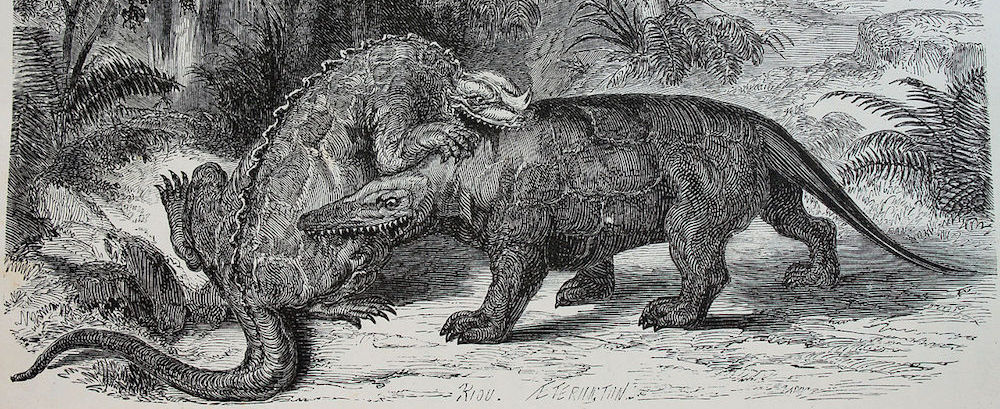Appendix:
Welcome back to Museum of Natural Mystery, everyone! Today’s exhibit attempts to answer what you might think would be a simple question: What was the first dinosaur to be called a dinosaur?
Of course, answers never come so easily in natural history. Famous paleontologist Richard Owen first coined the term “dinosauria,” meaning “terrible lizards,” in 1842, but not before several creatures fitting the category had already been discovered. Here’s a look at the first dinosaurs to bear the name:
Megalosaurus

Technically, Richard Owen grouped three dinosaurs under “dinosauria” at the same time, so all three are considered have crossed the finish line together. Chronologically, however, megalosaurus was the first to be discovered and named, and is hailed as the first recognized dinosaur.

Today, we know megalosaurus is about as generic a meat-eating dinosaur as they come. It could be described as a more boring version of tyrannosaurus or allosaurus, but in its heydey, it was the most exciting predator the world had ever seen. If you’re thinking it started out looking like the image above, though, you’d be as mistaken as the scientists who first tried to put it together.

First described by William Buckland (previously appearing in the Mary Anning exhibit!), megalosaurus was initially thought to be some sort of long-legged land crocodile, capable of hunting on land and in the water.

It wasn’t until the 1880’s, after the discovery of several distinguishably two-legged dinosaurs like the compsognathus, that scientists re-examined megalosaurus remains as a potential two-legged therapod dinosaur, though they still didn’t get it exactly right:


For nearly a century, dinosaurs were thought to walk in an upright posture, dragging their tails on the ground the way reptiles do. However, while fossilized dinosaur tracks contain footprints, they lack any drag marks that would indicate their tails ever touched the ground.

This tells us that dinosaurs must have carried their tails parallel to the ground, likely for balance, bringing us to the modern interpretation of dinosaur skeletal structure.

Iguanodon

About the same time Buckland was working on announcing megalosaurus, a physician and naturalist named Gideon Mantell uncovered the fossil tooth of an enormous herbivore. Because the tooth resembled that of a tiny species of iguana, he dubbed the creature iguanodon.

Like Buckland, Mantell imagined his creature as essentially a massive reptile. His initial depictions of the creature resemble a large iguana with a rhinoceros-like horn (we’ve since learned that this protrusion is actually a thumb-spike, most likely for defense).

Mantell would describe his find shortly after Buckland released his own paper on the megalosaurus. Later on, after categorizing iguanodon under “dinosauria,” Richard Owen would oversee the creation of sculptures of the known dinosaurs of the day, including iguanodon. The models were sculpted by artist Benjamin Waterhouse Hawkins, who famously invited Owen and about 20 other prominent individuals to a feast inside the enormous iguanodon sculpture before its completion.


Owen insisted on rendering the iguanodon sculptures in a sort of elephantine, straight-legged manner, which Mantell actually disagreed with. Upon closer inspection, Mantell realized that iguanodon’s forelimbs were shorter than its hind limbs and Owen’s vision for the model must be inaccurate. Unfortunately, Mantell fell ill and Owen took advantage of his absence to press ahead with the model such as it was.
Of course, time has proven Mantell correct. In the 1880’s, another iguanodon skeleton from Belgium, assembled by paleontologist Louis Dollo, revealed the dinosaur’s true form. Dollo set aside the notions that iguanodon needed to be a big lizard and placed the bones where they seemed to best fit together instead, giving us a mostly accurate iguanodon skeleton. There was one exception though: he positioned the dinosaur in that famous, upright stance with the tale dragging on the ground.


There’s some debate now as to whether or not Mantell’s iguanodon and Dollo’s iguanodon are actually the same animal, but at the time, it was assumed to be a more complete find of Mantell’s dinosaur. Due to iguanodon’s popularity, the image of the upright dinosaur was a seen around the world, ingraining such depictions in popular culture until, really, about the time Jurassic Park dropped in 1993.


Now that we understand dinosaurs didn’t drag their tails on the ground, scientists do think iguanodon probably spent a fair amount of its time on all fours after all. Mantell’s hunch about iguanodon’s limb size and how it walked might’ve actually been more accurate than a century’s worth of ideas that followed.

Hylaeosaurus

In 1832, Gideon Mantell discovered another giant reptile, known as hylaeosaurus. This time, it appeared to be a reptile with defensive spines along its back. Although met with less fanfare than its predecessors, Hylaeosaurus was a firm indicator that these large, dragon-like beasts weren’t some fluke of nature. They were going to keep turning up, which meant some sort of classification was going to be needed for all of these creatures, prompting Owen’s work a decade later.

Unlike megalosaurus and iguanodon, there’s never been any doubt that hylaeosaurus walked on four legs. While it was originally imagined with a ridge of spikes down it’s spine, naturalists of the era only scratched the surface of its defenses. We’ve since discovered that hylaeosaurus had armor plates shielding its back, with knobs and spikes to protect from predators.

Sources:
William Buckland – Oxford Museum of Natural History
Geology and Mineralogy considered with reference to Natural Theology by William Buckland
Notice on the Megalosaurus or great Fossil Lizard of Stonesfield by William Buckland
Megalosaurus and the Balance of Nature by Brian Switek
Iguanodon: Reconstruction of A Dinosaur by Dino Hunters
Dinosaur: Fossil Reptile by Kevin Padian, John H. Ostram
The Dinosaurs of 1960: A 50th Anniversary Photo Retrospective by Steve Biodrowski
Museum Management:
Museum theme by Michael Guy Bowman
Listen to more at: bowman.bandcamp.com
Rachel: Designer #UkuleleWitch @rachelvice
Tour Guide: Emery Coolcats
Twitter: @natmysterycast | Email: natmysterypodcast@gmail.com | Home: pome-mag.com/category/pomecast
Follow the show on iTunes or Soundcloud!
Museum of Natural Mystery is part of the POMEcast network, and thanks a million to the ladies of POME for helping this show get up and running! But above all, thank you for listening!




